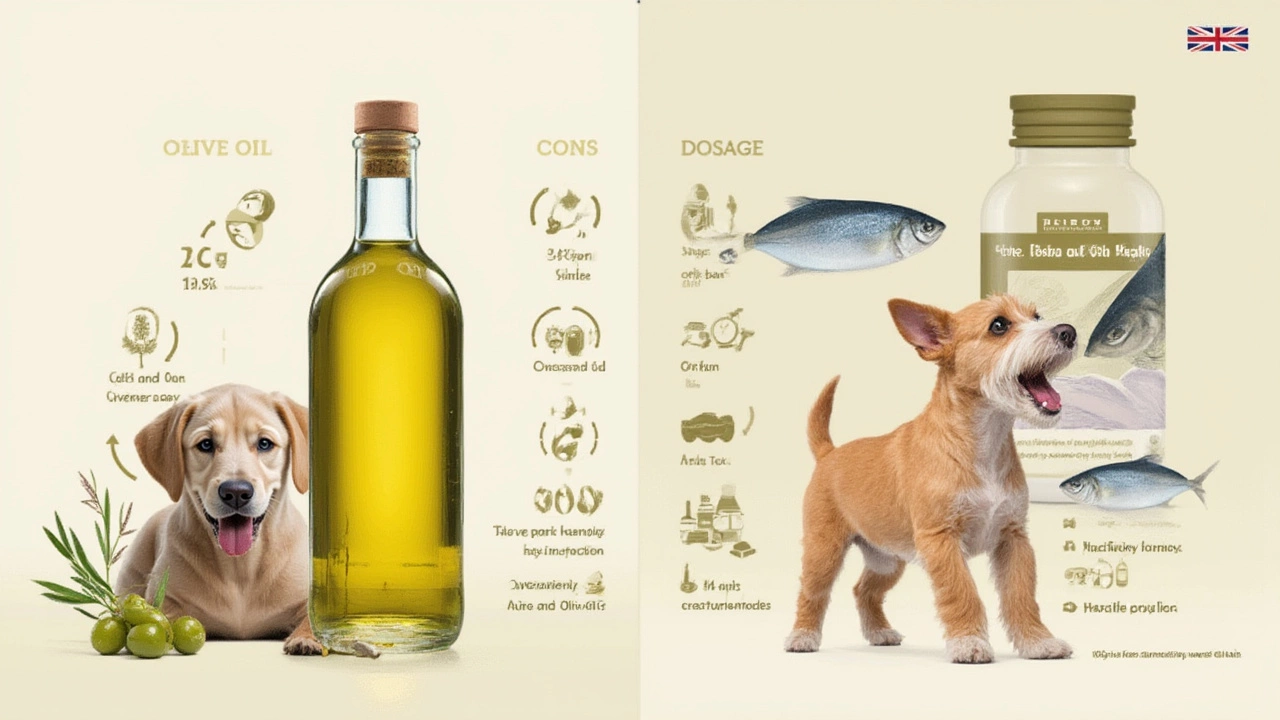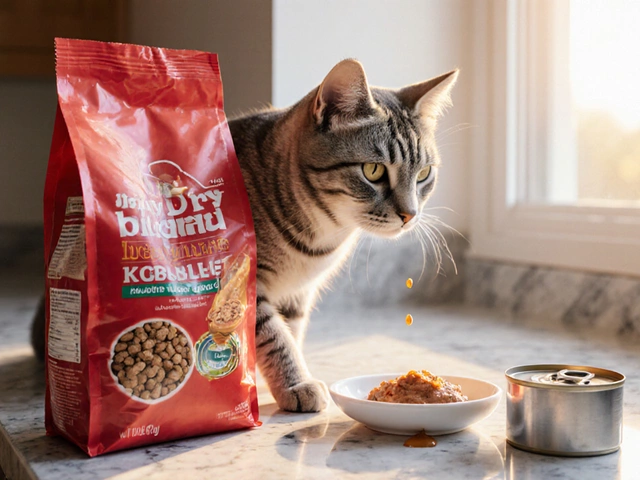Ever slipped your dog a piece of salmon and watched their eyes light up? Or maybe you’ve drizzled a little olive oil over kibble to see if it makes dinner disappear any faster. You’re not alone—pet parents everywhere are looking for simple ways to boost their dog’s health, and oils are a hot topic. But here’s where things get tricky: everyone claims one miracle oil is better than the other, and pet store shelves don’t exactly make it easier. Should you grab that rich green bottle of olive oil or stick with the fishy stuff your dog’s nostrils are already twitching for? The answer might actually surprise you.
What’s Inside Each Bottle: Olive Oil and Fish Oil Compared
The big difference between olive oil and fish oil comes down to their fat profile—specifically, the kinds of fatty acids they bring to your dog’s bowl. Olive oil, especially the extra virgin kind, is packed with monounsaturated fats. These are heart-healthy fats known to support a shiny coat and soft skin. Olive oil also holds a decent punch of antioxidants, like vitamin E and polyphenols, which help fight off cell damage inside your dog’s body. If your pup suffers from dry skin, a drizzle of olive oil might change the game—some pet owners swear their dogs itch less after just a week or two.
Fish oil, on the other hand, is all about the omega-3s. You’ll see numbers like EPA (eicosapentaenoic acid) and DHA (docosahexaenoic acid) on bottles—these two omega-3s are known for knocking inflammation into next week. Dogs dealing with arthritis, allergies, or chronic shedding could see real improvement. Veterinarians sometimes suggest fish oil for puppies, too, since DHA helps brain and eye development. Fish oil is kind of like that secret weapon for joint health, brain power, and even heart protection. There isn’t much vitamin E in fish oil naturally, though, so brands often add a dash to the mix.
Let's break down some real numbers. Every teaspoon (about 5 ml) of olive oil supplies around 40 calories and nearly 4.5 grams of pure fat—mostly the monounsaturated kind. Fish oil, especially salmon oil, packs about the same calories and fat per teaspoon but delivers up to 1,000 mg of omega-3s. That’s way more than you’ll find in a similar dose of olive oil, which barely scratches 100 mg of omega-3s per serving. Here’s a quick side-by-side:
| Oil | Main Fat | Omega-3 (mg/teaspoon) | Key Benefits |
|---|---|---|---|
| Olive Oil | Monounsaturated | ~100 mg | Antioxidants, skin & coat, mild anti-inflammatory |
| Fish Oil | Polyunsaturated (Omega-3) | ~900–1,000 mg | Arthritis, itching, coat, brain & eye health |
That’s the science side, but your dog doesn’t eat nutrients—he eats food. So, how do these fatty acids show up in your dog’s life? Olive oil may keep his fur soft and his stools moving along, but if you’re trying to seriously tackle inflammation—from creaky knees to red, raw paws—fish oil’s omega-3s easily run circles around olive oil.
Benefits of Olive Oil for Dogs: Not Just for Cooking
Let’s set the record straight—olive oil isn’t just the thing you splash on salads. For dogs, it can work wonders in ways you might not expect. First up: skin and coat health. If your dog has dandruff or seems to shed like crazy every spring, a tiny splash of olive oil could help. The vitamin E and antioxidants soothe irritated skin, and the fats help lock in moisture. In a study done at the University of Messina in Italy, dogs given a diet rich in extra virgin olive oil showed better skin elasticity and less dryness than those on regular chow.
Olive oil can also give your dog's digestive system a gentle nudge. A little oil on food helps dogs with mild constipation by greasing the wheels (or, in this case, the gut). Plus, the polyphenols in olive oil support gut bacteria, which means smoother digestion and less stinky breath. Not all benefits are just about looks or comfort, though. Those antioxidants support your dog’s immune system, working quietly behind the scenes to chase off cell damage—sort of like a built-in cleanup crew against pollutants and stress.
Got an older dog? You might see them walk a little easier after a few weeks on olive oil, especially if their joints are stiff from age. While olive oil doesn’t pack the same anti-inflammatory punch as fish oil, its monounsaturated fats still help take the edge off inflammation. Some vets recommend mixing a teaspoon of olive oil per 20 pounds of your dog’s weight into food every day. Go slow, though—add too much too fast, and you’ll learn the hard way just how quickly a dog’s tummy can rebel.
One important call-out: not all olive oils are created equal. Skip the cheap, light, or blended options. The real magic is in extra virgin olive oil, which means it’s pressed with minimal heat and holds onto more nutrients. Dark green glass bottles usually mean the oil’s fresher and less likely to go rancid on your counter. Once open, try to use it within two months for best results.
A cool trick if your dog is on the picky side—soak a thin slice of whole-wheat bread in a bit of extra virgin olive oil. Dogs usually love it, and it’s an easy way to sneak in the benefits without fighting over the dinner bowl. Olive oil can also make medicines go down easier—simply coat a pill or capsule and see if your stubborn pup finally gives in.
Of course, a little goes a long way. Too much olive oil, and you’ll just end up with a dog who needs to “go” every hour. Obesity is always a risk if you load up your dog’s food with more fat than he actually burns. A teaspoon per 20 pounds daily is the safe zone for most dogs, but always check with your vet, especially if your dog is on a calorie-restricted diet or has a sensitive GI tract.

The Power of Fish Oil: Omega-3s and More
Fish oil almost always makes the list for top dog supplements, and for a good reason. If you’ve got a dog with allergies, arthritis, or a double coat that never stops shedding, fish oil feels like a magic remedy. The alpha hero here is omega-3 fatty acids, mainly EPA and DHA. These work behind the scenes to calm the body’s fiery responses to injury or irritation. In fact, a Cornell University study found that dogs with osteoarthritis who scored fish oil daily showed more energy and less joint stiffness—owners even noticed their pups were willing to play fetch again.
If itchy skin, chronic licking, or weird rashes have ever made you book a rushed vet visit, omega-3s are your new best friend. These fatty acids help turn down the allergic response, so dogs scratch less and heal faster. This is especially helpful for breeds like bulldogs, retrievers, or poodles, which seem to be magnets for environmental allergies or food reactions.
There’s also brain power to think about. DHA isn’t just good for human babies—puppies need it, too. Feed companies often add fish oil to puppy kibble for developing eyesight and brain function, especially in the crucial first year. If you want a sharp, clever pup who picks up new tricks fast, that extra DHA does matter.
Of course, not all fish oils are created equal. The most popular sources include salmon oil, anchovy oil, and sardine oil. Try to choose wild-caught options when you can, as farmed fish often have more contaminants. Third-party testing by companies like the National Animal Supplement Council or ConsumerLab helps weed out cheap, rancid, or polluted products.
Worried about heavy metals? Good news—most reputable fish oil brands purify their products so mercury isn’t a concern. Trace amounts of vitamin E in formulas helps keep the oil stable and safe. Once opened, fish oil should live in the fridge, away from heat and sunlight, and used up within three months to keep it fresh (and to prevent your dog’s dinner from smelling like a dead fish market).
Dosing matters, too. Too much fish oil can thin blood, cause loose stool, or even slow healing from surgery, so stick with about 75–100 mg of combined EPA and DHA total per kilogram of body weight daily (that’s around 1,000 mg for a 50-pound dog). Ask your vet for the right amount, especially if your dog is on other medicines or has health conditions—some dogs on blood thinners or certain steroids need extra caution.
When to Use Olive Oil vs Fish Oil for Your Dog
If you’re still staring at your pantry (or your phone’s shopping cart) trying to decide, look at your dog’s needs. Skin a little flaky? Coat missing its silky shine? Olive oil is mild, easy to use, and most dogs tolerate it well. Dogs already eating fish-based foods or those with sensitive tummies often do better starting with olive oil in small doses. For constipation? Olive oil can loosen things up quickly.
But if your dog has chronic itching, hot spots, allergies, or arthritis, head straight for the fish oil. The omega-3s actually get to the root of inflammation, versus just covering up symptoms on the surface. Senior dogs, large breeds prone to joint problems, and puppies needing brain support all see more powerful and targeted results from fish oil.
Some owners try both. A half teaspoon of olive oil in breakfast kibble, and a squirt of fish oil in dinner. No need to choose sides if your pup’s healthy and happy with both, but watch out for extra calories. Remember, adding fat means adjusting the rest of your dog’s diet to keep his waistline trim and joints light.
If your dog has pancreatitis, diabetes, or is on a prescription diet—pause before you add anything. These conditions need a closer look by your vet. But for most healthy pups, either oil is safe when introduced slowly and in small amounts.
Trouble getting your dog to try new oils? Mix them into something irresistible, like unsweetened pumpkin puree or plain Greek yogurt. Start with a few drops before working up to a teaspoon, and watch for any signs of gas, vomiting, or diarrhea. If you notice anything off, back down the amount and try again at a slower pace.

Tips, Tricks, and What Vets Say About Oil Supplements
Veterinarians hear the question about olive oil versus fish oil all the time. Their answer? It really depends on your dog’s history, breed, and health goals. Vets love fish oil for allergy-prone, arthritic, or high-shedding breeds. If your vet suggests omega-3s, ask about dosing and brand—they usually have favorites for purity and taste. Olive oil gets the nod for dogs who need help moving their bowels, minor skin dryness, or when cost is a big factor (olive oil is cheaper and stores longer).
When shopping, quality matters more than the label. Look for omega-3 for dogs that’s free of additives, colors, or synthetic flavorings. Fish oil capsules made for humans can be fine in a pinch, but make sure there’s no xylitol or unnecessary extras. Liquid versions are easier to mix in food—just shake well and keep tightly sealed in the fridge.
Signs your dog is handling oil well include a shiny coat, more energy, and normal stools. Red flags? Watch for greasy fur, loose stool, vomiting, or refusal to eat. That’s your clue to slow down, cut the dose, or try another product. In rare cases, fish oil can interact with blood thinners, steroids, or some immune-suppressing drugs, so a quick call to your vet is the easiest peace of mind.
Making oil part of your dog’s routine doesn’t have to be a chore. Add oil to training treats, or try coating a lick mat with a bit of oil and some mashed banana—it becomes an instant boredom buster. And always store oils somewhere cool and out of sunlight; heat and oxygen are the enemy of freshness. Fish oil, in particular, goes bad fast—if it starts smelling super fishy, toss it.
- Keep the dose small to start—try half a teaspoon for little dogs, and never go over a tablespoon for big breeds without a vet’s okay.
- Don’t rely on oil alone to fix health concerns—keep up with regular checkups, a high-quality diet, and plenty of exercise.
- If your dog is prone to pancreatitis or weight gain, use oils with extreme caution and only under veterinary guidance.
- Mix oil with strong-smelling foods (like sardines or liver treats) for stubborn eaters. The taste blends right in.
- Keep a food journal to track changes in your dog’s coat, energy, stool quality, or allergy symptoms as you test new oils.
The most important takeaway? Oils are powerful, but they’re just one piece of a happy, healthy dog—and your pet’s unique quirks and needs come first. So whether your fridge holds a fancy bottle from Italy or your shelf sports a fishy squeeze-bottle from the pet store, a little knowledge makes all the difference. Your dog will thank you the next time he hits the park—and maybe even let you sleep in a little later without scratching all night long.





